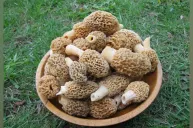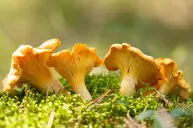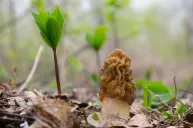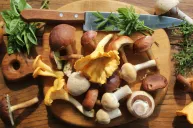Are you excited with thoughts of filling baskets of morel mushrooms to overflow capacity?
If morel mushrooms aren't already showing up where you live they soon will be. Are you mushroom hunters ready?
These delicious wild mushrooms aren't going to pick themselves!
Here are 10 quick tips to help fuel your morel mushroom hunting daydreams.
For hunting accessories, visit walmart.com.
1. The temperature is just right
I'm not saying that morels are fickle or anything, but they are a little like the baby bear who wanted his porridge to be "just right." Keep an eye on the temperature outside as morel season rolls in.
Morels like it when it starts to get around 60 degrees and above during the day, and night temperatures hover around 40 degrees.
Also, get yourself a soil thermometer and check the temperature of the soil where you hunt. Morels start popping up when the earth gets between 45 and 50 degrees.
2. The slope of the hill
The side of a hill that gets more sun will, of course, get warmer before the other side. That's where morels will start showing up first. Check those south-facing slopes early in the season.
3. Know your trees
Morels can be tree huggers. Learn to identify the trees (with and without their leaves) that morels like to hang around and you'll be more successful. Elm, ash, poplar and apple trees are well-known morel mushroom favorites. Look for dead and dying trees, too.
4. The lay of the land
Morels like loamy soil. Loamy soil is what you might find in creek bottoms. It's well-drained, moist but not wet. It has a good mix of clay, sand, decaying matter, calcium and or lime. I've found morels growing in gravel and under pine trees.
5. Disturbed ground is good ground
Burn sites and logging areas are often prime morel locations. Check online sources for wildfires that occurred the previous year in your area. The Global Incident Map for forest fires is a site that tracks current and past wildfires. Pay attention to wooded areas that have been torn up by large equipment or logging operations. Morels like areas that have also been disturbed by flooding.
6. After a rain
A warm spring rain can be just the right medicine for getting morels to show themselves. If the temperatures are right (see No. 1 above) and you get a nice rain, mark the following day on the calendar as "morel hunting" day.
7. Pack a lunch
Of course you can head out to hunt and harvest mushrooms, and then go right home to clean and cook them. But most of the best days I've had hunting morels, whether I've found mushrooms or not, have been the days that I brought a light lunch to enjoy in the field.
Sitting down with your back to a tree, with a sandwich and a thermos of hot coffee or tea, is a simple pleasure not to be missed. You might even pack a small camp stove, pan, and a tin of butter to easily fry up a few dried morels right there. You'll probably find that they taste even better when eaten in the woods.
8. Other tasty treats
Morels and fiddleheads go together like peas and carrots. Keep an eye out for ostrich fern fiddleheads (not all fern fiddleheads are edible, so be sure to properly identify). Ramps are also a spring delicacy. A basket full of fresh morels, fiddleheads and ramps is a beautiful thing.
9. Take a few pictures
A camera is a wonderful item to bring with you when foraging. These days most smartphones have excellent cameras already included. Photos are also a great way to share your outing and any cool things you may see. A small journal is another useful item to record your observations and could be useful in planning future outings.
10. Those darn ticks
You may not find morels every time you hit the woods, but you can probably bet on a tick or few finding you. Lyme disease is not something to take lightly. Dress appropriately, use a tick repellent and be sure to give yourself a once-over when you get home.
Good luck, have fun, and good eating!
NEXT: HOW TO IDENTIFY SNAKES IN THE FIELD
WATCH
https://rumble.com/embed/u7gve.v3tp3v/





